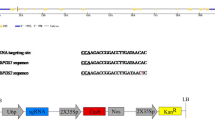Abstract
A method for reducing cytochimerism and inducing homogeneous tetraploids in Haplopappus gracilis (2n = 4) was developed in which masses of shoot primordia treated with 0.5 mg/ml of colcemid for 3 days were cut into small meristematic domes. All of the shoot primordia sampled just after the colcemid treatment were cytochimeras that were mixoploids of 2x, 4x and 8x cells. However, when they were allowed to recover in a colcemid-free medium, the frequency of 4x cells spontaneously increased in most of the shoot primordia. Thirty days after the recovery, chimeric masses containing shoot primordia, each of which consisted uniformly of 4x or 2x cells, were observed. In order to obtain a completely homogeneous tetraploid mass, we then cut these primordia into small pieces, each of which had approximately one meristematic dome. Subsequent to this homogeneous tetraploid masses were easily obtained. Tetraploid shoot primordia could propagate with chromosomal stability over a year, and plants regenerated from these tetraploid shoot primordia were also completely tetraploid. These results show that non-chrimeric masses can be easily isolated from artificially induced cytochimeras using masses of shoot primordia as material.
Similar content being viewed by others
References
Aitken-Christie J, Singh AP, Davies H (1988) Multiplication of meristematic tissue: a new tissue culture system for radiata pine. In: Hanover JW, Keathley DE (eds) Genetic manipulation of woody plants. Plenum Press, New York London, pp 413–432
Ashmore SE, Shapcott AS (1989) Cytogenetic studies of Haplopappus Gracilis in both callus and suspension cell cultures. Theor Appl Genet 78:249–259
Bayliss MW (1980) Chromosomal variation in plant tissues in culture. Int Rev Cytol Suppl 11A:113–144
Broertjes C, van Harten AM (1985) Single cell origin of adventitious buds. Euphytica 34:93–95
Fukui K (1983) Sequential occurrence of mutations in a growing rice callus. Theor Appl Genet 65:225–230
Gamborg OL, Miller RA, Ojima K (1968) Nutrient requirements of suspension cultures of soybean root cells. Exp Cell Res 50:151–158
Heinz DJ, Mee GWP (1971) Morphologic, cytogenetic, and enzymatic variation in Saccharum species hybrid clones derived from callus tissue. Am J Bot 58:257–262
Hermsen JGTh, Ramanna MS, Roest S, Bokelmann GS (1981) Chromosome doubling through adventitious shoot formation on in vitro cultivated leaf explants from diploid interspecific potato hybrids. Euphytica 30:239–246
Jones LH (1974) Factors influencing embryogenesis in carrot cultures (Daucus carota L.). Ann Bot 38:1077–1088
Mehra A, Mehra PN (1974) Organogenesis and plantlet formation in vitro in almond. Bot Gaz 135:61–73
Mitra J, Mapes MO, Steward FC (1960) Growth and organized development of cultured cells. IV. The behavior of the nucleus. Am J Bot 47:357–368
Murashige T, Nakano R (1966) Tissue culture as a potential tool in obtaining polyploid plants. J Hered 57:115–118
Murashige T, Skoog F (1962) A revised medium for rapid growth and bioassays with tobacco tissue cultures. Physiol Plant 15:473–497
Nandi S, Fridborg G, Eriksson T (1977) Effects of 6-(3-methyl-2-buten-1-ylamino)-purine and α-naphthaleneacetic acid on root formation and cytology of root tips and callus in tissue cultures of Allium cepa var. proliferum. Hereditas 85:57–62
Nessler CL (1982) Somatic embryogenesis in the opium poppy, Papaver somniferum. Physiol Plant 55:453–458
Pareek LK, Chandra N (1978) Differentiation of shoot buds in vitro in tissue cultures of Sisymbrium irio L. J Exp Bot 29:239–244
Pierik RLM (1987) In vitro culture of higher plants. Martinus Nijhoff Publ, Dordrecht Boston Lancaster
Pierik RLM, Steegmans HHM (1983) Vegetative propagation of a chimerical Yucca elephantipes Regel in vitro. Sci Hortic 21:267–272
Sacristán MD (1971) Karyotypic changes in callus cultures from haploid and diploid plants of Crepis capillaris (L.) Wallr. Chromosoma 33:273–283
Sacristán MD, Melchers G (1969) The caryological analysis of plants regenerated from tumorous and other callus cultures of tobacco. Mol Gen Genet 105:317–333
Singh BD, Harvey BL (1975) Cytogenetic studies on Haplopappus gracilis cells cultured on agar and in liquid media. Cytologia 40:347–354
Tanaka R, Ikeda H (1983) Perennial maintenance of annual Haplopappus gracilis (2n=4) by shoot tip cloning. Jpn J Genet 58:65–70
Tanaka R, Taniguchi K, Kamisugi Y (1985) Induction of single cell stage in tissue cultured shoot primordia of Haplopappus gracilis (2n=4), a preliminary report. Jpn J Genet 60:405–410
Tanaka R, Taniguchi K, Miyagawa H, Fujishige I, Ikeda H (1988a) Stock of chromosome-types and tissue cultured shoot primordium (in Japanese with English summary). J Pharm Soc Jpn 108:1023–1039
Tanaka R, Taniguchi K, Fujishige I (1988b) Artificial induction of clonal tetraploids in an annual plant, Haplopappus gracilis (2n=4), by using tissue cultured shoot primordia. Jpn J Genet 63:113–125
Taniguchi K, Tanaka R (1989) Induction of shoot primordia from calli of Crepis capillaris (2n = 6) and regeneration of plantlets. Jpn J Genet 64:199–208
Thorpe TA, Murashige T (1970) Some histochemical changes underlying shoot initiation in tobacco callus cultures. Can J Bot 48:277–285
Torrey JG (1966) The initiation of organized development in plants. Adv Morphog 5:39–91
Wakizuka T, Yamaguchi T (1987) The induction of enlarged apical domes in vitro and multi-shoot formation from finger millet (Eleusine coracana). Ann Bot 60:331–336
White DWR (1984) Plant regeneration from long-term suspension cultures of white clover. Planta 162:1–7
Author information
Authors and Affiliations
Additional information
Communicated by K. Tsunewaki
Rights and permissions
About this article
Cite this article
Fujishige, I., Tanaka, R. & Taniguchi, K. Efficient isolation of non-chimeric tetraploids artificially induced in a stable culture of Haplopappus gracilis . Theoret. Appl. Genetics 92, 157–162 (1996). https://doi.org/10.1007/BF00223370
Received:
Accepted:
Issue Date:
DOI: https://doi.org/10.1007/BF00223370




